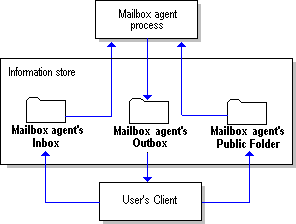About Mailbox Agents
Although the objectives and tasks of Microsoft Exchange Server servicesvary, they share a common information structure because they use standard interfaces and common objects. The following figure shows a simplified view of this common information-exchange structure as it applies to a mailbox agent.

Interfaces between a mailbox server, a client, and a mailbox on Microsoft Exchange Server
-
The main components and objects pictured in the diagram are defined below.
-
Userís client application Can include unextended Microsoft Exchange clients, custom-built applications, and extended versions of the Microsoft Exchange Client.
-
Mailbox agent process A server application that provides server functions and communicates using a mailbox on the information store. Mailbox agents may also include a public folder for information sharing.
-
Information store Acts as the primary information database for Microsoft Exchange Server.
-
Inbox Receives messages from users for the application.
-
Outbox Stores and sends messages to users from the application.
-
Public folder Folder within the information store that contains information to be shared with application users. Because of their flexibility and power, public folders are suitable for almost any kind of information-exchange application.
For information about this type of server application, see SMBAGENT: Creating a Sample Mailbox Agent.

